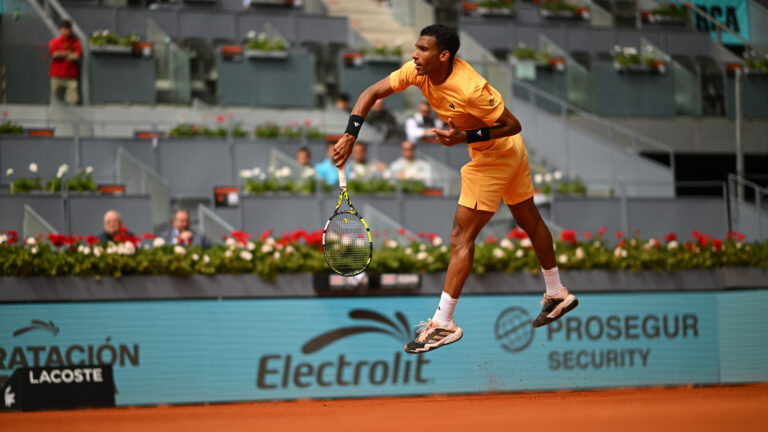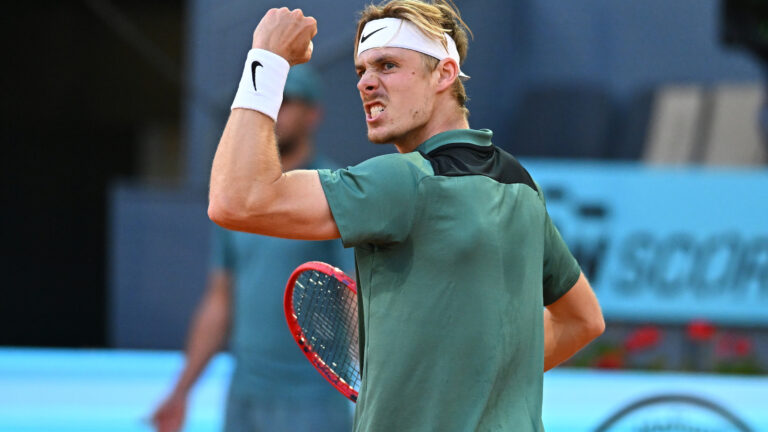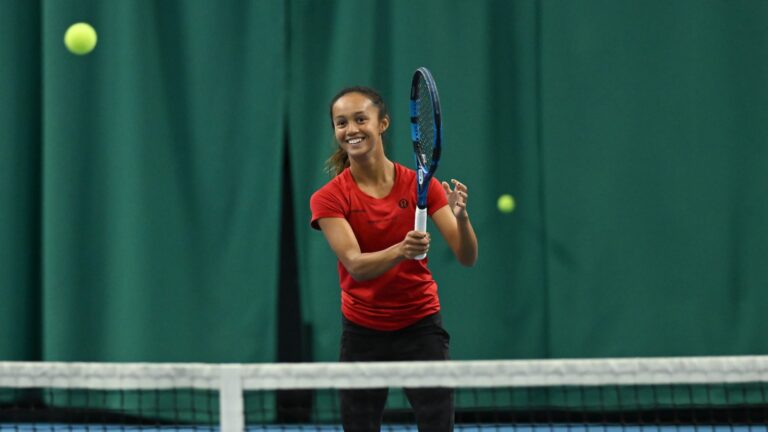TEBBUTT: PARISIAN SUMMER IS HERE

Mauricio Paiz
When Julien Benneteau stepped out of the locker rooms on Friday morning on the way to the practice courts with doubles partner Edouard Roger-Vasselin, he exclaimed “c’est estival aujourd’hui,” (it’ summery today).
It was indeed, with a high of 28 degrees C in the afternoon. Later, when Novak Djokovic was going off the court after defeating Ernests Gulbis in the men’s semi-final, he walked over below the ‘Tribune Présidentielle’ and told French Tennis Federation president Jean Gachassin, “il fait tres chaud aujourd’hui” (it’s really hot today). Gachassin replied, “il fera moins chaud dimanche” (it will be less hot on Sunday).
But not that much – maybe around 26 degrees, which would still be a lot warmer than it has been during the whole tournament. That’s the kind of weather that Rafael Nadal prefers, and could be a significant factor in favour of the Spaniard in the final.
On Court 3 early on Friday, the day was definitely much warmer than anything thus far at the 2014 French Open. But it probably wasn’t a factor in Francoise Abanda’s 6-4, 6-0 loss to top seed Ivana Jorovic in the semi-finals of the junior girls event.

Mauricio Paiz
Abanda trailed 5-2 in the opening set but rallied with some aggressive hitting to 5-4 down and serving. She had two points for 5-all but her 17-year-old Serbian opponent (above) saved them.
Abanda later revealed that her elbow was painful and that one of her toe nails was giving her a problem.
“I had two points for 5-all in the first set, after I missed them and I knew that it would be hard to win the match in three sets because I already wasn’t feeling very good,” she explained.
“The other girl (Jorovic) was playing well and I don’t want to sound like I’m making excuses.”
In the second set, it was one-way traffic for Jorovic as Abanda made an abundance of unforced errors.

Trailing 5-0, she called for the trainer and it took about 12 minutes for her to get to the court, do an examination and then wrap Abanda’s toe.
“My toe was hurting me the whole match, every time I stopped,” she said. “I really pushed it to the limit, so at 5-0 I really wanted to see the physio. It had started to bleed – so I just wanted her to see it and take care of it. For sure it’s tough for the girl who’s leading 5-0 and wants to finish the match – but I know the rule and needed the treatment.”

Upon resumption, it took just five points for Jorovic to finish the bagel set.
Abanda already has a WTA ranking of No. 262 but she is still keen to play the junior Grand Slam events.
“It’s a prestigious tournament and it would really be nice to win it,” she said about Roland Garros. “It’s too bad I wasn’t 100 per cent in terms of my tennis. And there were some of the best players (now in the pros) who are not here – (Belinda) Bencic and (Ana) Konjuh – so it was a good chance for me to go and win my first title. But it’s a junior tournament and aiming for a career as a pro.”

Mauricio Paiz
Abanda’s plan now is to return to Montreal and see a doctor. If everything is okay, she intends to play the pre-Wimbledon junior tournament at Roehampton and then junior Wimbledon.
Abanda, 17, grew up just speaking French in Montreal but has now become proficient in English. “Three or four years ago, I didn’t speak a word of English,” she said. “But I was forced to learn it because I was constantly with English speakers. Ralph Platz was one of the coaches with me for a long time so I had to learn.”
She is very active on social media and admitted with a smile, “yes, I tweet a lot more in English now.”
THE MYSTERIOUS MINUTE CHANGE-OVER

Well here is the explanation for the one-minute change-overs in the Bouchard – Sharapova match on Thurday.
I spoke with Rémy Azémar, the Roland Garros assistant referee, and he said that it is always one minute at ITF events and Grand Slam tournaments. That the umpire calls ‘time’ at the one minute mark so the players can be playing by the time 90 seconds is reached.
The Grand Slam rule book reads, “when changing ends a maximum of (90) seconds shall elapse from the moment the ball goes out of play at the end of a game until the first serve is struck for the next game.”
In the first men’s semi-final on Friday between Novak Djokovic and Ernests Gulbis – there were change-overs, before time was called, of 75, 70 and 63 seconds.
Here’s what ATP executive vice-president Rules & Competition, Gayle Bradshaw, explained about change-overs at ATP events:
>> For ATP matches – time is called at 60” and play should be within an additional 30”; however, for televised matches time may be called at 90” and play must begin within 30” from when time was called.
For set breaks the timing is: time called at 90” and play within additional 30” but for television this can be extended to time at 120” and play within an additional 30”. <<
That’s why, during the change-overs at ATP events, often you will hear the umpire before the match say that there are “TV change-overs.” That means 90 second between when the point ends and the players hear “time” and have to get up and walk out on the court.
That’s why fans watching major ATP matches on television know they have a minimum 90-second “TV change-over” to use for household chores and other matters during the break. That extra 30 seconds can sometimes come in handy.
PARIS POST CARD

This is a fresco on the front of a very nice apartment building on rue Poussin along the way to Roland Garros. The phrase, in old French, can be translated as “happiness is in the love of the family.”


